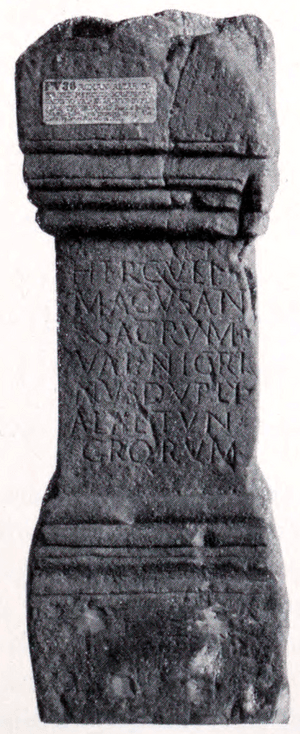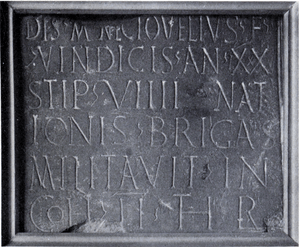Mumrills facts for kids
Mumrills was the biggest Roman fort built on the Antonine Wall in Scotland. The Antonine Wall was a huge barrier made by the Romans to protect their land. Mumrills was an important part of this wall, helping to keep watch and control the area.
Contents
Discovering Mumrills
Archaeologists dug up the site of Mumrills in the 1920s and again in the late 1950s. These digs helped them figure out exactly where the fort was and what its shape looked like. It was like putting together a giant puzzle from hundreds of years ago!
Messages from the Past
When people dig up old places like Mumrills, they often find amazing things. These finds help us learn about the people who lived there long ago.
Stone Carvings and Altars
One special stone found near Mumrills was an altar dedicated to Hercules Magusanus. Hercules was a famous Roman hero, and "Magusanus" was a special name for him used by a group of people from what is now the Netherlands. This altar was found in 1841 and is now kept in a museum in Scotland.
Another altar found at Mumrills was dedicated to the Matres, who were like "mother goddesses." A soldier named Cassius, who served at the fort, dedicated this altar. It was carved between 140 and 165 AD, which tells us when the Romans were active there.
A Soldier's Story in Stone
A very interesting stone found at Mumrills is a tombstone for a soldier named Nectovelius. It tells us he was 30 years old and from a Celtic tribe called the Brigantes, who lived in what is now northern England. He served for nine years in the "Second Cohort of Thracians," which was a Roman army unit. This stone shows that the Roman army used soldiers from the local areas they conquered.
What Else Was Found?
Archaeologists found many other items at Mumrills that give us clues about daily life.
Everyday Objects
In 1987, a stone carving of Hercules was found in a garden nearby. Other finds include parts of a tombstone, a heavy iron chisel, iron tongs, and a special kind of Roman concrete made from crushed tiles. They also found a cooking pot and a box flue tile, which was used in Roman heating systems.
Life in the Fort
Most Roman forts like Mumrills held about 500 soldiers. Larger forts sometimes had 1000 men. Even though soldiers weren't officially allowed to marry, it's thought that women and children also lived near the forts. There were probably big communities of civilians (people who weren't soldiers) living around Mumrills too.
By looking at animal bones and shells found at the fort, we can guess what the soldiers and civilians ate. They also found signs of buildings that might have been used for "smelly" jobs like tanning leather or working with metal (smithing). A hearth (a fireplace) was also found, which would have been used for cooking or heating.
Mumrills also had special defensive ditches called lilia pits. These were holes with sharpened stakes at the bottom, hidden from enemies. You can still see examples of these pits at another Roman fort called Roughcastle.
Images for kids








